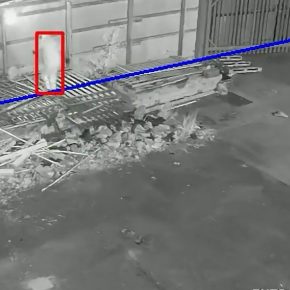
GUEST ARTICLE: 1 in 4 construction workers robbed at work
A damning new report shows theft on building sites is surging nationwide, forcing a quarter of vulnerable construction workers to replace the cost of stolen tools as the country grapples with the cost-of-living crisis. This guest article explores the findings…
The Unseen Threats: 2024 Construction Crime Index from site security firm BauWatch interviewed 500 construction workers to understand their experience of crime. Shockingly, it found that small tools were the most commonly stolen item on sites, ahead of copper (36%), cable (31%), fuel (20%), and large vehicles (12%) – all seemingly more valuable items.
The surprising discovery showed that 1 in 4 workers have been left out of pocket after having to replace stolen tools, with the same number admitting that being robbed is their ‘biggest fear’ when it comes to onsite security at work. 7 in 10, meanwhile, admit to seeing theft on site as regularly as once a year – suggesting it’s endemic to the sector – with two-thirds reporting the problem has worsened in 2023.
Despite the obvious risk, over a third of workers claim security is a ‘low priority’ on sites they work on, with 17% of respondents citing budget restraints as a leading cause.

Break-ins increasingly common in light of slowing economy
Ben Hancock, Managing Director of Oscar Acoustics, which specialises in architectural acoustic finishes, says he’s had several vehicles broken into in the wake of economic strain.
“Thieves actively target white work vans as they think high-value tools are inside,” he says.
“We now have a policy of not leaving equipment in vans, even temporarily. That said, even if the crooks leave empty-handed, it’s still a headache, as we have to get the vans repaired and repainted, which will leave us a team down and negate project timelines.
“The costs to us go far beyond repairs, and the situation is so bad we now have an additional van in our fleet purely to cover break-ins.”
Rico Wojtulewicz, Head of Policy and Market Insight at the National Federation of Builders, adds: “We’ve observed that, since the Government removed the construction industry’s access to red diesel, fuel theft has risen, as indicated by responses in this crime index.”
Firms need to protect staff – and resources
Firms don’t appreciate who they’re dealing with when it comes to site crime, says BauWatch MD Alexis Potter.
“We already know a lot of construction crime is the work of insiders or organised professionals, and at least 42% of workers we spoke to agree,” he says.
“While staff do have a responsibility to look after their kit, when faced with enemies like this, they need outside support. Given some workers report having to replace the cost of tools themselves, it’s worrying that they don’t feel confident about on-site security.
“It raises key questions about their safety, not to mention their morale, which is already a challenge for this sector.”
Annabel Hiatt, Hire Category Manager at Travis Perkins, adds: “Stealing materials and equipment from construction sites is not just costly and frustrating – it’s damaging to taxpayers and communities.
“With the rising cost of living, materials inflation, and darker evenings accelerating criminal activity, there’s never been a better time for construction firms to consider easily deployable security solutions.”
Deterrence is vital
The report urges firms to tighten security and includes best-practice advice on how to do that.
Alexis concludes: “Deterrence is key when it comes to theft, as once the damage is done it’s done. So things like CCTV, alarms, and fencing, should be in place.
“Clear communication and regular, systematic training help empower teams to safeguard construction sites. Most importantly, be agile, as threats are constantly evolving.”
The 2024 Construction Crime Index report can be downloaded here.
Latest news

26th July 2024
Enfield Speciality Doors completes world-class project for Atlas Copco HQ
A rundown office and warehouse building completely transformed into a modern headquarters for Atlas Copco has been fitted with more than 120 internal fire doors from Enfield Speciality Doors.
Posted in Access Control & Door Entry Systems, Articles, Building Industry News, Building Products & Structures, Building Systems, Case Studies, Doors, Interior Design & Construction, Interiors, Posts, Restoration & Refurbishment, Retrofit & Renovation, Security and Fire Protection, Sustainability & Energy Efficiency, Timber Buildings and Timber Products, Wooden products
26th July 2024
Abloy UK launches new white paper
Abloy UK, a leading provider of security and access control solutions, has launched a new white paper.
Posted in Access Control & Door Entry Systems, Architectural Ironmongery, Articles, Building Industry News, Building Products & Structures, Building Services, Doors, Facility Management & Building Services, Health & Safety, Information Technology, Innovations & New Products, Publications, Research & Materials Testing, Security and Fire Protection
26th July 2024
MCRMA Member Profile: David Roy, Director of Roofconsult
David Roy of MCRMA member company Roofconsult has more than 50 years’ experience to draw upon working in the building envelope sector and a unique perspective on how it has changed in that time.
Posted in Articles, BIM, Infrastructure & CAD Software, Building Associations & Institutes, Building Industry News, Building Products & Structures, Building Services, Building Systems, Cladding, Information Technology, Restoration & Refurbishment, Retrofit & Renovation, Roofs, Walls
26th July 2024
Strand: Enhancing Door Functionality and Safety
Craig Fox, Sales Director for Strand Hardware, outlines how door industry professionals might apply door limiting stays…
Posted in Architectural Ironmongery, Articles, Building Industry News, Building Products & Structures, Building Services, Doors, Facility Management & Building Services, Health & Safety, Restoration & Refurbishment, Retrofit & Renovation
 Sign up:
Sign up: